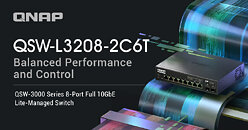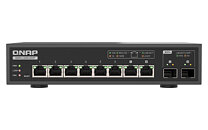
Shuttle Launches New XPC nano NE10N Fanless Mini PC Platform
With the XPC nano NE10N, Shuttle introduces a fanless mini PC platform that impresses with its compact design and robust technology. Developed for reliable 24/7 continuous operation, the barebone is particularly suitable for digital display solutions, control systems, POS applications and for use in office and media environments.
Inside the NE10N is a 12th generation Intel N100 processor (Alder Lake-N), which offers solid computing power with completely passive cooling despite a TDP of only 6 watts. The absence of active fans ensures silent operation and reduces maintenance requirements - a clear advantage in sensitive or hard-to-reach installations. Despite a housing volume of only 0.6 liters, the system offers a wide range of expansion options: a DDR4 SO-DIMM slot for up to 16 GB RAM, an M.2 2280 slot for NVMe or SATA SSDs, and an optional M.2 2230 slot with pre-installed WLAN antennas for wireless network connection. The integrated Intel UHD graphics unit enables simultaneous operation of two Ultra HD displays via HDMI 2.0 and DisplayPort 1.4.
Inside the NE10N is a 12th generation Intel N100 processor (Alder Lake-N), which offers solid computing power with completely passive cooling despite a TDP of only 6 watts. The absence of active fans ensures silent operation and reduces maintenance requirements - a clear advantage in sensitive or hard-to-reach installations. Despite a housing volume of only 0.6 liters, the system offers a wide range of expansion options: a DDR4 SO-DIMM slot for up to 16 GB RAM, an M.2 2280 slot for NVMe or SATA SSDs, and an optional M.2 2230 slot with pre-installed WLAN antennas for wireless network connection. The integrated Intel UHD graphics unit enables simultaneous operation of two Ultra HD displays via HDMI 2.0 and DisplayPort 1.4.












































































